1997 SSANGYONG KORANDO display
[x] Cancel search: displayPage 985 of 2053

SECTION 4F
ANTILOCK BRAKE SYSTEM AND
TRACTION CONTROL SYSTEM
TABLE OF CONTENTS
General Description and System Opertion..........4F-3
Basic Knowledge Required...................................4F-3
ABS System Components...................................4F-3
Traction Control System (TCS) Description...........4F-3
EBD System........................................................4F-5
EBD Failure Matrix...............................................4F-6
Tires and ABS/TCS..............................................4F-7
Hydraulic Circuit...................................................4F-8
ABS 5.3...............................................................4F-8
ABS/TCS 5.3.....................................................4F-11
Component Locator...........................................4F-14
ABS, ABS/TCS 5.3............................................4F-14
Diagnosis............................................................4F-15
Diagnostic Circuit Check....................................4F-15
ABS Indicator Lamp Inoperative.........................4F-18
Traction Control System (TCS) Indicator Lamp
Inoperative.....................................................4F-22
EBD Indicator Lamp Inoperative.........................4F-26
Power Supply to Control Module,
No DTCs Stored..............................................4F-30
ABS Indicator Lamp Illuminated Continuously,
No DTCs Stored..............................................4F-34
Self-Diagnostics................................................4F-36
Displaying DTCs................................................4F-36
Clearing DTCs...................................................4F-36
Intermittents and Poor Connections....................4F-36
DTC 03 - Left Front Wheel Speed Sensor Fault ...4F-38
DTC 07 - Left Front Wheel Speed Sensor
Continuity Fault...............................................4F-40
DTC 04 - Right Front Wheel Speed Sensor
Fault...............................................................4F-42DTC 08 - Right Front Wheel Speed Sensor
Continuity Fault...............................................4F-44
DTC 05 - Left Rear Wheel Speed Sensor Fault....4F-46
DTC 09 - Left Rear Wheel Speed Sensor
Continuity Fault...............................................4F-48
DTC 06 - Right Rear Wheel Speed Sensor Fault .4F-50
DTC 10 - Right Rear Wheel Speed Sensor
Continuity Fault...............................................4F-52
DTC 11 - Wheel Speed Sensor Frequency Error ..4F-54
DTC 42 - Acceleration Sensor Fault....................4F-58
DTC 43 - Acceleration Sensor Continuity Fault.....4F-60
DTC 13/14 - Left Front Inlet and Outlet Valve
Solenoid Fault.................................................4F-62
DTC 15/16 - Right Front Inlet and Outlet Valve
Solenoid Fault.................................................4F-64
DTC 17/18 - Left Rear Inlet and Outlet Valve
Solenoid Fault.................................................4F-66
DTC 19/20 - Right Rear Inlet and Outlet Valve
Solenoid Fault.................................................4F-68
DTC 21/22 - Left Rear Prime Line and Traction
Control System (TCS) Pilot Valve Fault............4F-70
DTC 23/24 - Right Rear Prime Line and Traction
Control System (TCS) Pilot Valve Fault............4F-72
DTC 12 - Valve Relay Circuit Fault......................4F-74
DTC 24 - Pump Motor or Pump Motor
Relay Fault.....................................................4E-76
DTC 27 - Stoplamp Switch Fault.........................4E-80
DTC 28 - Low Voltage Fault................................4E-84
DTC 02 - ABS Control Module Internal Fault........4E-88
Scheatic and Routing Diagrams........................4E-90
ABS Circuit (Without TCS): Gasoline...................4E-90
ABS/TCS Circuit: Gasoline.................................4E-91
ABS/ABD (Automatic Brake
Differential Lock): Diesel.................................4E-93
Page 999 of 2053

SSANGYONG MY2002
4F-16 ABS AND TCS
1. Install the scan tool.
2. Turn ignition switch to ON.
3. Select the Data List mode.
Is the scan tool receiving data from the electronic
brake control module (EBCM)?
Check the display.
Are there any current DTCs displayed?
1. Turn the ignition to LOCK for 10 seconds.
2. Turn the ignition to ON and observe the ABS
indicator.
Does the indicator light for 2 seconds and then go off?
Check the ABS indicator.
Did the ABS indicator turn on and stay on?
Check whether the vehicle is equipped with traction
control.
Is the vehicle equipped with traction control?
1. Turn the ignition to LOCK for 10 seconds.
2. Turn the ignition to ON and observe the TCS
indicator.
Does the indicator light for 2 seconds and then go off?
1. Turn the ignition to LOCK.
2. Disconnect the EBCM harness connector.
3. Turn the ignition to ON.
4. Use a digital voltmeter (DVM) to measure the
voltage from ground to terminal 1 and 50 of the
EBCM harness connector.
Is the voltage equal to the specified value?
1. Turn the ignition to LOCK.
2. Use a DVM to measure the resistance from the EBCM
harness connector, terminals 28 and 29 to ground.
Is the resistance equal to the specified value?
Repair the open in the circuit that failed.
Is the repair complete?
Use a DVM to measure the resistance between
terminal 46 of the EBCM harness connector and
terminal 8 of the data link connector (DLC).
Is the resistance below the specified value?
Replace the ABS unit.
Is the repair complete?
Repair the open or high resistance in circuit BrG
between terminal 11 of the EBCM harness connector
and terminal 13 of the DLC.
Is the repair complete?
Perform the road test described above.
Are any DTCs set? Step
1
2
3
4
5
6
7
8
9
10
11
12
13
Diagnostic Circuit Check
Action Yes
Go to Step 2
Refer to the
applicable DTC
table
Go to Step 5
Go to “ABS
Indicator Lamp
Illuminated
Constantly”
Go to Step 6
Go to Step 13
Go to Step 8
Go to Step 10
System OK
Go to Step 11
System OK
Go to Step 1
Go to the table
for the DTCNo
Go to Step 7
Go to Step 3
Go to Step 4
Go to
“ABS Indicator
Lamp Inopera-
tive
Go to Step 13
Go to “Traction
Control System
Indicator Lamp
Inoperative”
Go to “Power
Supply to
Control Mod-
ule, No DTCs
Stored
Go to Step 9
-
Go to Step 12
-
-
System OK Value(s)
-
-
-
-
-
-
11 - 14 v
≈ 0 Ω
-
2 Ω
-
-
-
Page 1019 of 2053
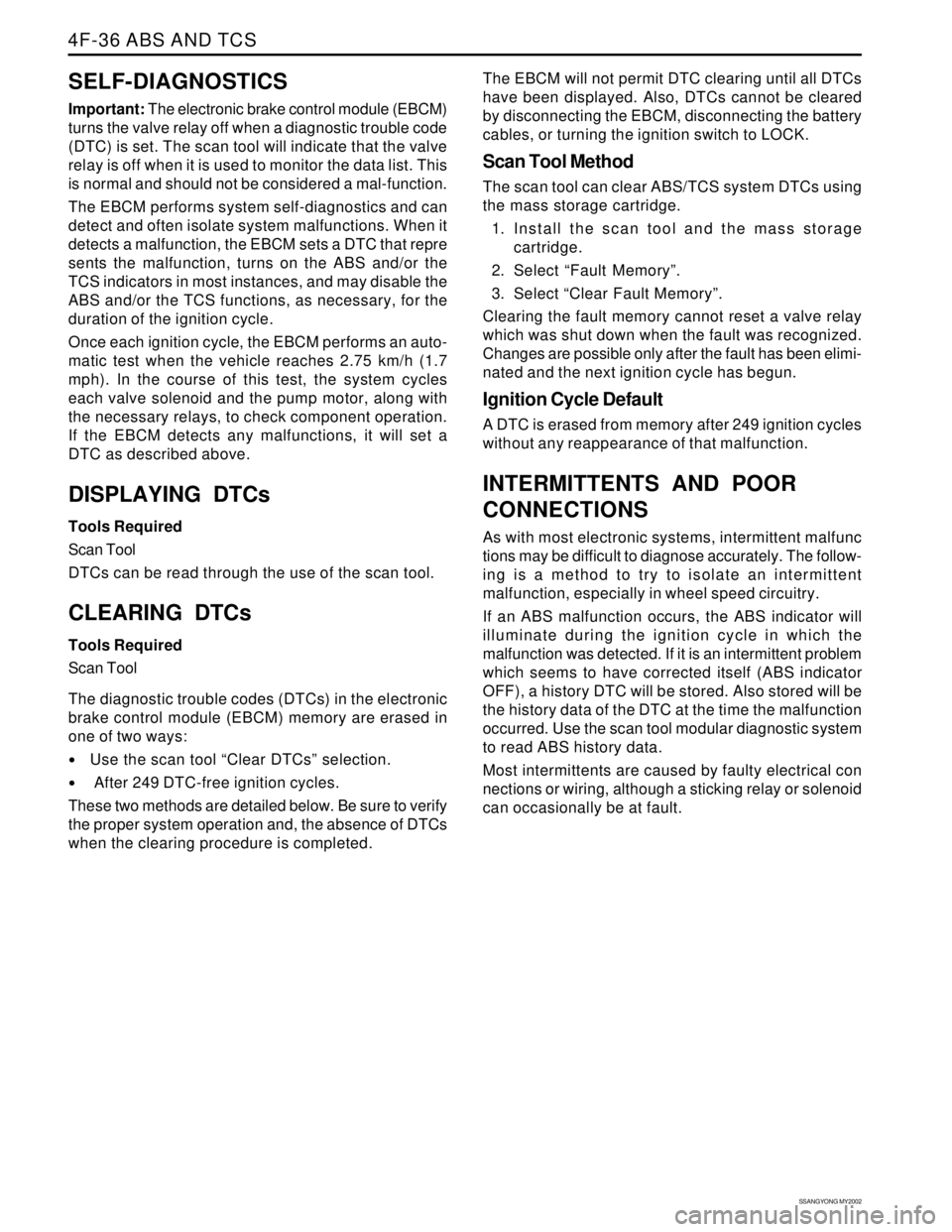
SSANGYONG MY2002
4F-36 ABS AND TCS
SELF-DIAGNOSTICS
Important: The electronic brake control module (EBCM)
turns the valve relay off when a diagnostic trouble code
(DTC) is set. The scan tool will indicate that the valve
relay is off when it is used to monitor the data list. This
is normal and should not be considered a mal-function.
The EBCM performs system self-diagnostics and can
detect and often isolate system malfunctions. When it
detects a malfunction, the EBCM sets a DTC that repre
sents the malfunction, turns on the ABS and/or the
TCS indicators in most instances, and may disable the
ABS and/or the TCS functions, as necessary, for the
duration of the ignition cycle.
Once each ignition cycle, the EBCM performs an auto-
matic test when the vehicle reaches 2.75 km/h (1.7
mph). In the course of this test, the system cycles
each valve solenoid and the pump motor, along with
the necessary relays, to check component operation.
If the EBCM detects any malfunctions, it will set a
DTC as described above.
DISPLAYING DTCs
Tools Required
Scan Tool
DTCs can be read through the use of the scan tool.
CLEARING DTCs
Tools Required
Scan Tool
The diagnostic trouble codes (DTCs) in the electronic
brake control module (EBCM) memory are erased in
one of two ways:
Use the scan tool “Clear DTCs” selection.
After 249 DTC-free ignition cycles.
These two methods are detailed below. Be sure to verify
the proper system operation and, the absence of DTCs
when the clearing procedure is completed.The EBCM will not permit DTC clearing until all DTCs
have been displayed. Also, DTCs cannot be cleared
by disconnecting the EBCM, disconnecting the battery
cables, or turning the ignition switch to LOCK.
Scan Tool Method
The scan tool can clear ABS/TCS system DTCs using
the mass storage cartridge.
1. Install the scan tool and the mass storage
cartridge.
2. Select “Fault Memory”.
3. Select “Clear Fault Memory”.
Clearing the fault memory cannot reset a valve relay
which was shut down when the fault was recognized.
Changes are possible only after the fault has been elimi-
nated and the next ignition cycle has begun.
Ignition Cycle Default
A DTC is erased from memory after 249 ignition cycles
without any reappearance of that malfunction.
INTERMITTENTS AND POOR
CONNECTIONS
As with most electronic systems, intermittent malfunc
tions may be difficult to diagnose accurately. The follow-
ing is a method to try to isolate an intermittent
malfunction, especially in wheel speed circuitry.
If an ABS malfunction occurs, the ABS indicator will
illuminate during the ignition cycle in which the
malfunction was detected. If it is an intermittent problem
which seems to have corrected itself (ABS indicator
OFF), a history DTC will be stored. Also stored will be
the history data of the DTC at the time the malfunction
occurred. Use the scan tool modular diagnostic system
to read ABS history data.
Most intermittents are caused by faulty electrical con
nections or wiring, although a sticking relay or solenoid
can occasionally be at fault.
Page 1021 of 2053
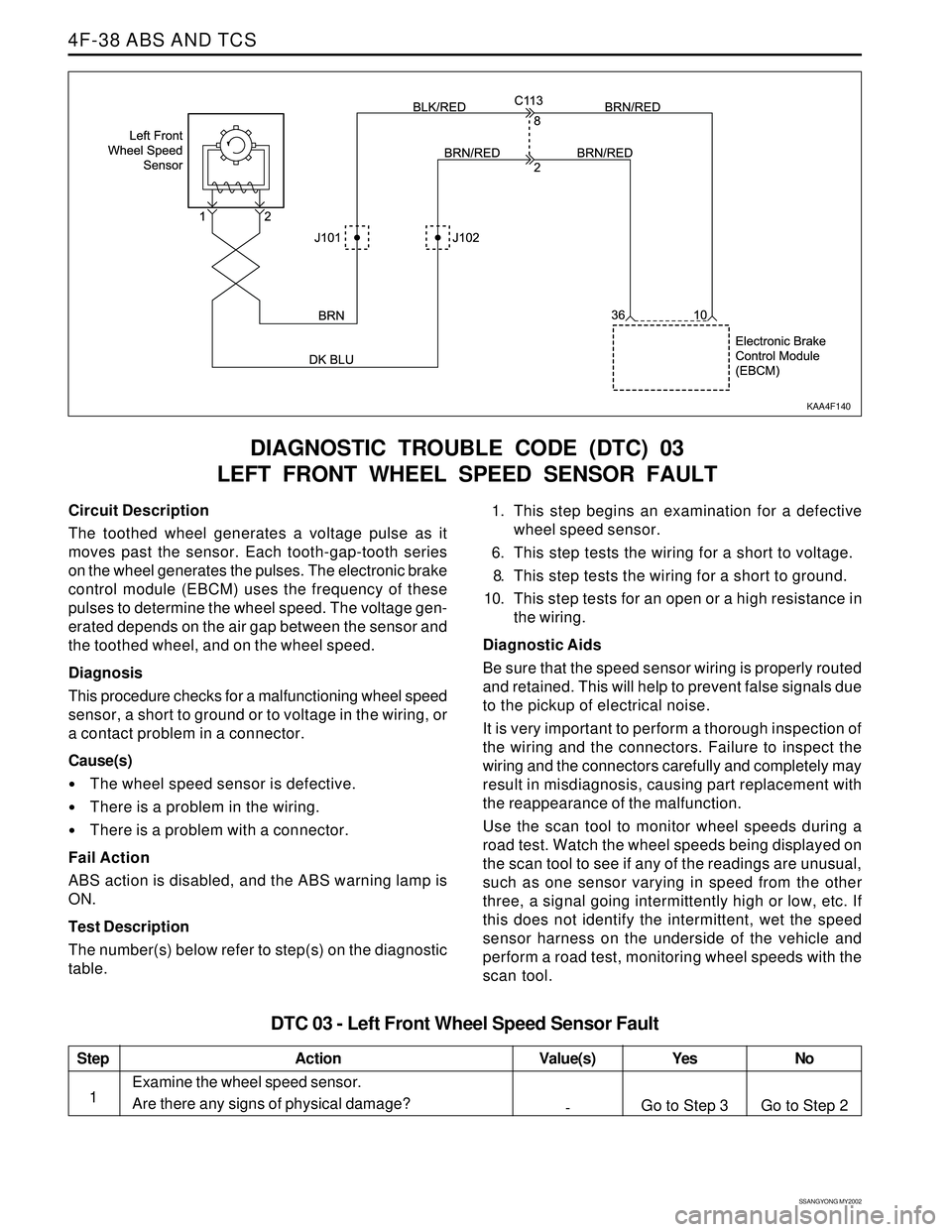
SSANGYONG MY2002
4F-38 ABS AND TCS
DIAGNOSTIC TROUBLE CODE (DTC) 03
LEFT FRONT WHEEL SPEED SENSOR FAULT
KAA4F140
Circuit Description
The toothed wheel generates a voltage pulse as it
moves past the sensor. Each tooth-gap-tooth series
on the wheel generates the pulses. The electronic brake
control module (EBCM) uses the frequency of these
pulses to determine the wheel speed. The voltage gen-
erated depends on the air gap between the sensor and
the toothed wheel, and on the wheel speed.
Diagnosis
This procedure checks for a malfunctioning wheel speed
sensor, a short to ground or to voltage in the wiring, or
a contact problem in a connector.
Cause(s)
The wheel speed sensor is defective.
There is a problem in the wiring.
There is a problem with a connector.
Fail Action
ABS action is disabled, and the ABS warning lamp is
ON.
Test Description
The number(s) below refer to step(s) on the diagnostic
table.1. This step begins an examination for a defective
wheel speed sensor.
6. This step tests the wiring for a short to voltage.
8. This step tests the wiring for a short to ground.
10. This step tests for an open or a high resistance in
the wiring.
Diagnostic Aids
Be sure that the speed sensor wiring is properly routed
and retained. This will help to prevent false signals due
to the pickup of electrical noise.
It is very important to perform a thorough inspection of
the wiring and the connectors. Failure to inspect the
wiring and the connectors carefully and completely may
result in misdiagnosis, causing part replacement with
the reappearance of the malfunction.
Use the scan tool to monitor wheel speeds during a
road test. Watch the wheel speeds being displayed on
the scan tool to see if any of the readings are unusual,
such as one sensor varying in speed from the other
three, a signal going intermittently high or low, etc. If
this does not identify the intermittent, wet the speed
sensor harness on the underside of the vehicle and
perform a road test, monitoring wheel speeds with the
scan tool.
Step
1
DTC 03 - Left Front Wheel Speed Sensor Fault
Action Yes
Go to Step 3No
Go to Step 2 Value(s)
-
Examine the wheel speed sensor.
Are there any signs of physical damage?
Page 1025 of 2053
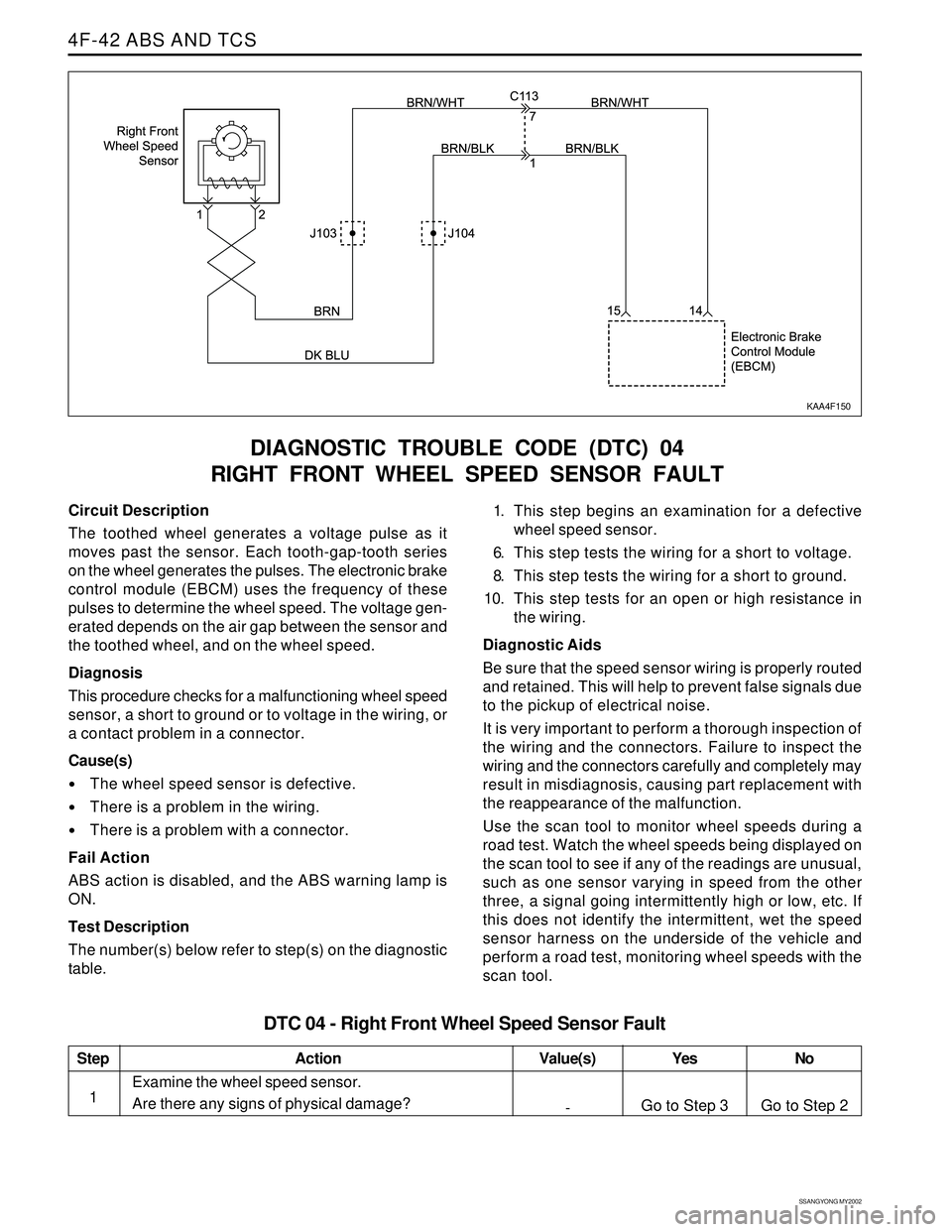
SSANGYONG MY2002
4F-42 ABS AND TCS
DIAGNOSTIC TROUBLE CODE (DTC) 04
RIGHT FRONT WHEEL SPEED SENSOR FAULT
KAA4F150
Circuit Description
The toothed wheel generates a voltage pulse as it
moves past the sensor. Each tooth-gap-tooth series
on the wheel generates the pulses. The electronic brake
control module (EBCM) uses the frequency of these
pulses to determine the wheel speed. The voltage gen-
erated depends on the air gap between the sensor and
the toothed wheel, and on the wheel speed.
Diagnosis
This procedure checks for a malfunctioning wheel speed
sensor, a short to ground or to voltage in the wiring, or
a contact problem in a connector.
Cause(s)
The wheel speed sensor is defective.
There is a problem in the wiring.
There is a problem with a connector.
Fail Action
ABS action is disabled, and the ABS warning lamp is
ON.
Test Description
The number(s) below refer to step(s) on the diagnostic
table.1. This step begins an examination for a defective
wheel speed sensor.
6. This step tests the wiring for a short to voltage.
8. This step tests the wiring for a short to ground.
10. This step tests for an open or high resistance in
the wiring.
Diagnostic Aids
Be sure that the speed sensor wiring is properly routed
and retained. This will help to prevent false signals due
to the pickup of electrical noise.
It is very important to perform a thorough inspection of
the wiring and the connectors. Failure to inspect the
wiring and the connectors carefully and completely may
result in misdiagnosis, causing part replacement with
the reappearance of the malfunction.
Use the scan tool to monitor wheel speeds during a
road test. Watch the wheel speeds being displayed on
the scan tool to see if any of the readings are unusual,
such as one sensor varying in speed from the other
three, a signal going intermittently high or low, etc. If
this does not identify the intermittent, wet the speed
sensor harness on the underside of the vehicle and
perform a road test, monitoring wheel speeds with the
scan tool.
Step
1
DTC 04 - Right Front Wheel Speed Sensor Fault
Action Yes
Go to Step 3No
Go to Step 2 Value(s)
-
Examine the wheel speed sensor.
Are there any signs of physical damage?
Page 1029 of 2053
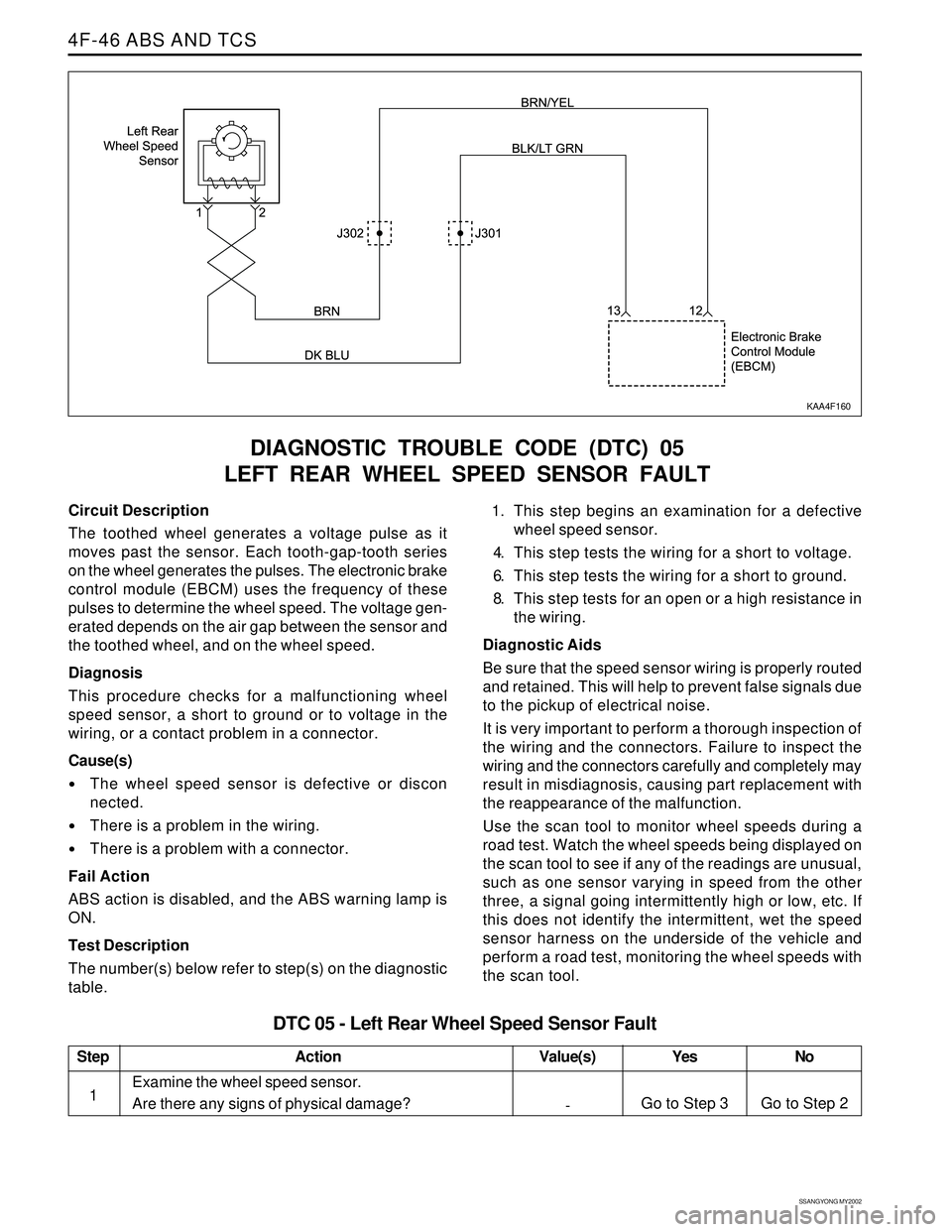
SSANGYONG MY2002
4F-46 ABS AND TCS
DIAGNOSTIC TROUBLE CODE (DTC) 05
LEFT REAR WHEEL SPEED SENSOR FAULT
KAA4F160
Circuit Description
The toothed wheel generates a voltage pulse as it
moves past the sensor. Each tooth-gap-tooth series
on the wheel generates the pulses. The electronic brake
control module (EBCM) uses the frequency of these
pulses to determine the wheel speed. The voltage gen-
erated depends on the air gap between the sensor and
the toothed wheel, and on the wheel speed.
Diagnosis
This procedure checks for a malfunctioning wheel
speed sensor, a short to ground or to voltage in the
wiring, or a contact problem in a connector.
Cause(s)
The wheel speed sensor is defective or discon
nected.
There is a problem in the wiring.
There is a problem with a connector.
Fail Action
ABS action is disabled, and the ABS warning lamp is
ON.
Test Description
The number(s) below refer to step(s) on the diagnostic
table.1. This step begins an examination for a defective
wheel speed sensor.
4. This step tests the wiring for a short to voltage.
6. This step tests the wiring for a short to ground.
8. This step tests for an open or a high resistance in
the wiring.
Diagnostic Aids
Be sure that the speed sensor wiring is properly routed
and retained. This will help to prevent false signals due
to the pickup of electrical noise.
It is very important to perform a thorough inspection of
the wiring and the connectors. Failure to inspect the
wiring and the connectors carefully and completely may
result in misdiagnosis, causing part replacement with
the reappearance of the malfunction.
Use the scan tool to monitor wheel speeds during a
road test. Watch the wheel speeds being displayed on
the scan tool to see if any of the readings are unusual,
such as one sensor varying in speed from the other
three, a signal going intermittently high or low, etc. If
this does not identify the intermittent, wet the speed
sensor harness on the underside of the vehicle and
perform a road test, monitoring the wheel speeds with
the scan tool.
Step
1
DTC 05 - Left Rear Wheel Speed Sensor Fault
Action Yes
Go to Step 3No
Go to Step 2 Value(s)
-
Examine the wheel speed sensor.
Are there any signs of physical damage?
Page 1033 of 2053

SSANGYONG MY2002
4F-50 ABS AND TCS
DIAGNOSTIC TROUBLE CODE (DTC) 06
RIGHT REAR WHEEL SPEED SENSOR FAULT
KAA4F170
Circuit Description
The toothed wheel generates a voltage pulse as it
moves past the sensor. Each tooth-gap-tooth series
on the wheel generates the pulses. The electronic brake
control module (EBCM) uses the frequency of these
pulses to determine the wheel speed. The voltage gen-
erated depends on the air gap between the sensor and
the toothed wheel, and on the wheel speed.
Diagnosis
This procedure checks for a malfunctioning wheel speed
sensor, a short to ground or to voltage in the wiring, or
a contact problem in a connector.
Cause(s)
The wheel speed sensor is defective or disconnected.
There is a problem in the wiring.
There is a problem with a connector.
Fail Action
ABS action is disabled, and the ABS warning lamp is
ON.
Test Description
The number(s) below refer to step(s) on the diagnostic
table.1. This step begins an examination for a defective
wheel speed sensor.
6. This step tests the wiring for a short to voltage.
8. This step tests the wiring for a short to ground.
10. This step tests for an open or high resistance in
the wiring.
Diagnostic Aids
Be sure that the speed sensor wiring is properly routed
and retained. This will help to prevent false signals due
to the pickup of electrical noise.
It is very important to perform a thorough inspection of
the wiring and the connectors. Failure to inspect the
wiring and the connectors carefully and completely may
result in misdiagnosis, causing part replacement with
the reappearance of the malfunction.
You can use the scan tool to monitor wheel speeds
during a road test. Watch the wheel speeds being
displayed on the scan tool to see if any of the readings
is unusual, such as one sensor varying in speed from
the other three, a signal going intermittently high or
low, etc. If this does not identify the intermittent, wet
the speed sensor harness on the underside of the
vehicle and perform a road test, monitoring the wheel
speeds with the scan tool.
Step
1
DTC 06 - Right Rear Wheel Speed Sensor Fault
Action Yes
Go to Step 3No
Go to Step 2 Value(s)
-
Examine the wheel speed sensor.
Are there any signs of physical damage?
Page 1041 of 2053
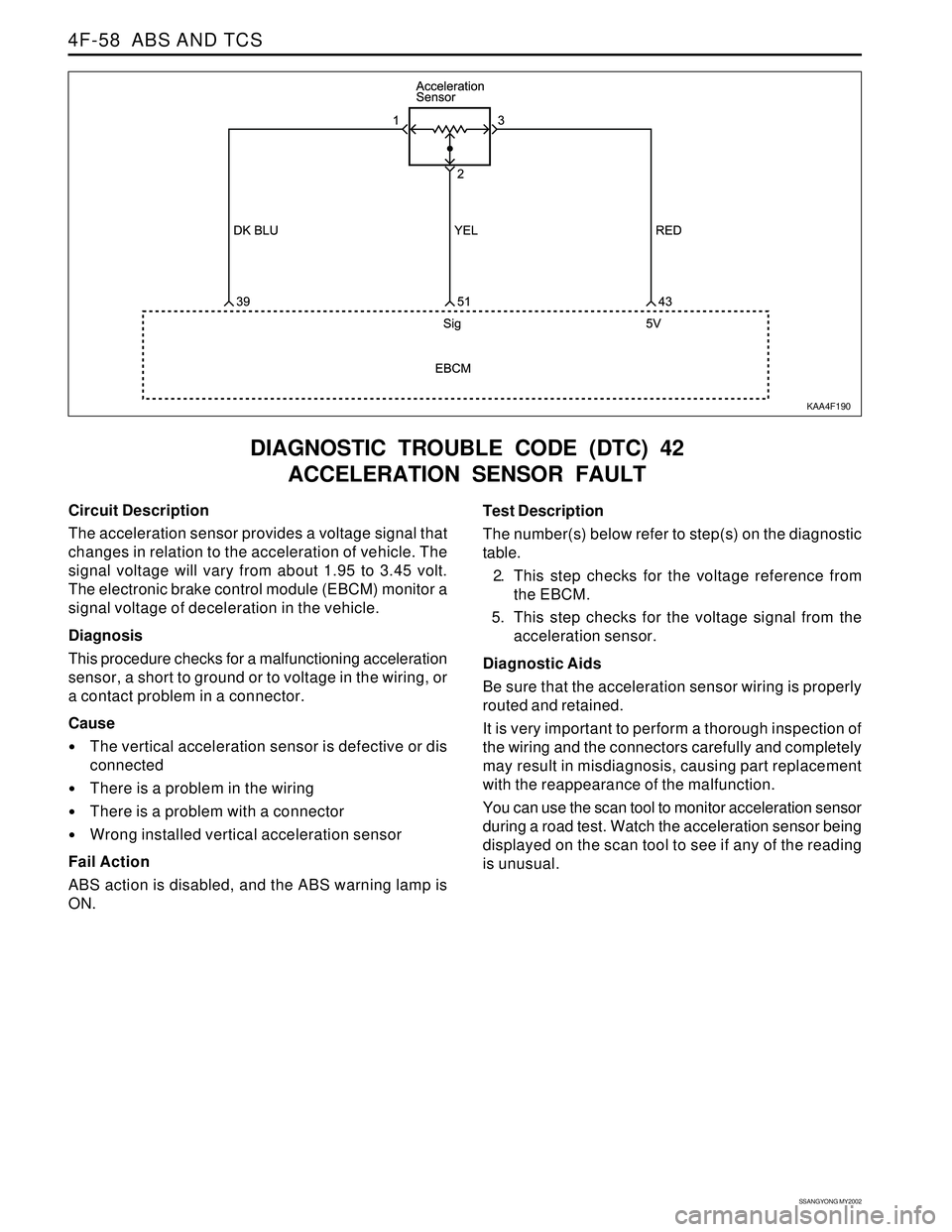
SSANGYONG MY2002
4F-58 ABS AND TCS
DIAGNOSTIC TROUBLE CODE (DTC) 42
ACCELERATION SENSOR FAULT
KAA4F190
Circuit Description
The acceleration sensor provides a voltage signal that
changes in relation to the acceleration of vehicle. The
signal voltage will vary from about 1.95 to 3.45 volt.
The electronic brake control module (EBCM) monitor a
signal voltage of deceleration in the vehicle.
Diagnosis
This procedure checks for a malfunctioning acceleration
sensor, a short to ground or to voltage in the wiring, or
a contact problem in a connector.
Cause
The vertical acceleration sensor is defective or dis
connected
There is a problem in the wiring
There is a problem with a connector
Wrong installed vertical acceleration sensor
Fail Action
ABS action is disabled, and the ABS warning lamp is
ON.Test Description
The number(s) below refer to step(s) on the diagnostic
table.
2. This step checks for the voltage reference from
the EBCM.
5. This step checks for the voltage signal from the
acceleration sensor.
Diagnostic Aids
Be sure that the acceleration sensor wiring is properly
routed and retained.
It is very important to perform a thorough inspection of
the wiring and the connectors carefully and completely
may result in misdiagnosis, causing part replacement
with the reappearance of the malfunction.
You can use the scan tool to monitor acceleration sensor
during a road test. Watch the acceleration sensor being
displayed on the scan tool to see if any of the reading
is unusual.